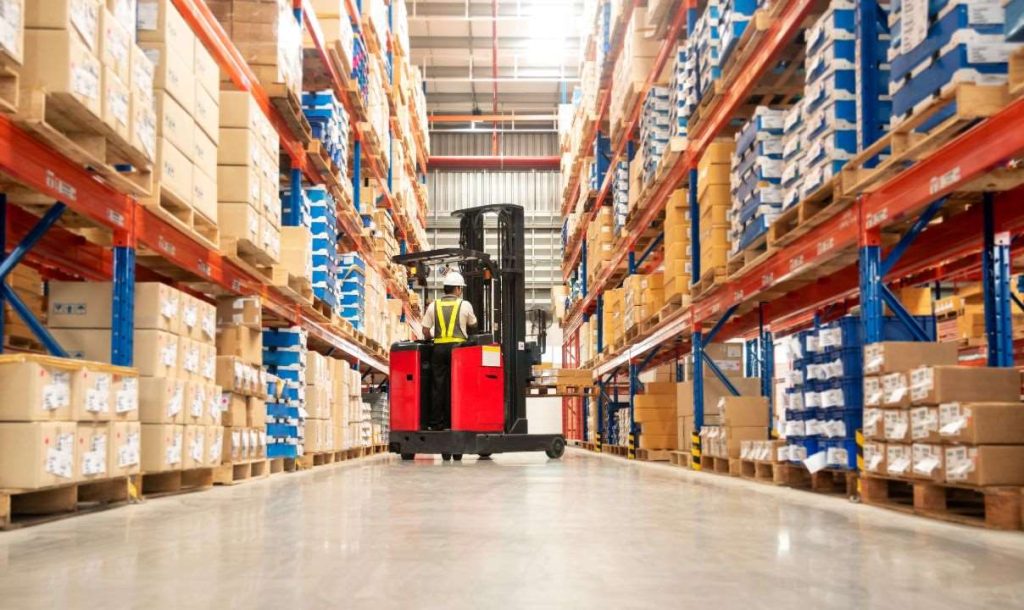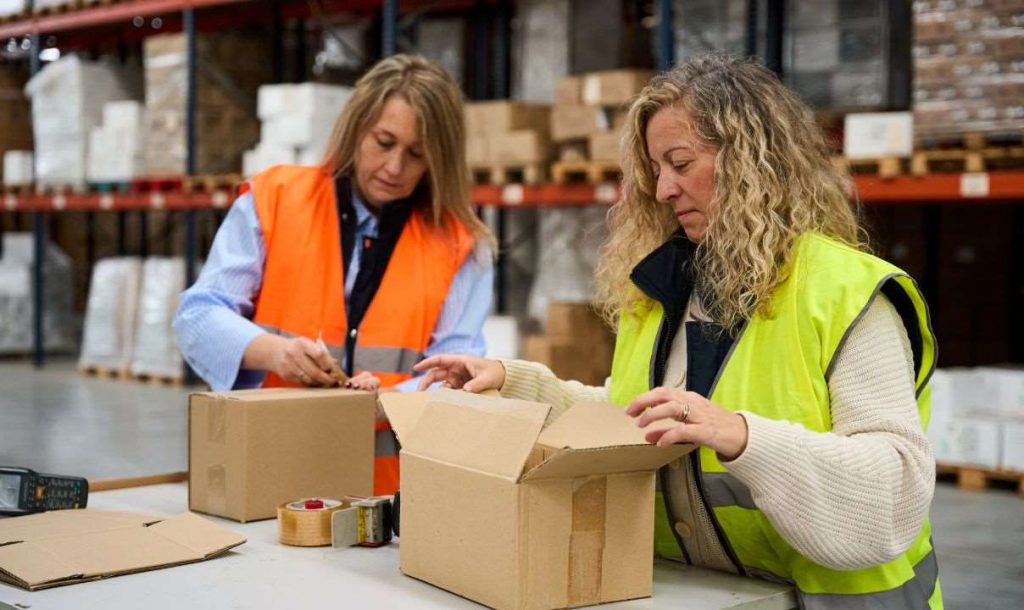The Unseen Engine of E-commerce Growth
Every successful e-commerce brand reaches a critical inflection point. The thrill of new orders gives way to a daunting reality: you spend more time buried in packing tape and navigating carrier websites than you do growing your business. Your living room becomes a makeshift warehouse, and the complex logistics of inventory management become a full-time job.
This operational bottleneck prevents you from scaling. When the very tasks that define your business—getting products to customers—are now holding it back, it’s a clear signal that you need to investigate a professional third-party fulfillment solution.
The Strategic Solution: Third-Party Fulfillment
This is where third-party fulfillment enters the picture. It is the strategic solution allowing ambitious e-commerce businesses to outsource their entire operational backend. By partnering with a third-party fulfillment provider, you hand over the physical logistics to focus on what you do best: marketing, product development, and customer engagement. A great 3PL fulfillment service is truly an engine for growth.
This ultimate guide will serve as your comprehensive roadmap to 3PL fulfillment. We will de-mystify this world, explaining what 3PL fulfillment is, how the process works, its immense benefits for both dropshippers and B2B sellers, and how to choose the right 3PL fulfillment partner to fuel your success.
De-mystifying 3PL: What is Third-Party Fulfillment?
Core Definition
A third-party fulfillment (commonly known as a 3PL) provider is an outsourced partner that manages a company’s warehousing, inventory, and shipping operations. Instead of leasing your own warehouse, you store your products in a third-party fulfillment center. When a customer places an order, it’s automatically sent to your third-party fulfillment provider, whose team then picks, packs, and ships the order directly to your customer. This level of integration is a hallmark of modern third-party fulfillment.
What’s Included? The Spectrum of 3PL Services
A modern third-party fulfillment partner offers a comprehensive suite of services designed to handle every aspect of your logistics. While offerings can vary, most top-tier third-party fulfillment providers include the following core services:
| Service | Description |
|---|---|
| Warehousing | Securely storing your inventory in a strategically located fulfillment center, optimized for efficiency and safety as part of a third-party fulfillment agreement. |
| Inventory Management | Utilizing advanced Warehouse Management Software (WMS) to track stock levels in real-time, manage SKUs, and support your third-party fulfillment needs. |
| Picking & Packing | Professionally locating the correct items for each order and packing them securely according to your brand’s specifications and third-party fulfillment profile. |
| Shipping | Coordinating with a network of shipping carriers (like FedEx, DHL, and USPS) to secure discounted rates and ensure fast, reliable delivery for your third-party fulfillment orders. |
| Returns Processing | Managing incoming returns (reverse logistics), inspecting products, and processing them for restocking, quarantine, or disposal. This is a critical part of a complete third-party fulfillment service. |
| Kitting & Assembly | Offering value-added services like bundling multiple products, creating subscription boxes, or light product assembly within the third-party fulfillment center. |

The Critical Distinction: 3PL vs. Traditional Dropshipping
Many entrepreneurs start with dropshipping but look to third-party fulfillment as the next evolutionary step.
- Traditional Dropshipping: You act as a middleman, never owning or handling inventory. When an order is placed, you pass it to your supplier, who ships directly to the customer.
- Pros: No upfront inventory investment.
- Cons: Extremely long shipping times, zero control over quality or packaging, no branding, and razor-thin profit margins.
- Third-Party Fulfillment (Dropshipping Fulfillment 2.0): This model gives you full control. You purchase inventory in bulk and ship it to your third-party fulfillment partner’s warehouse. They handle the shipping when a customer orders. This method of dropshipping fulfillment is superior for brand building.
- Pros: Fast shipping (2-5 days), complete control over custom branding, higher profit margins, and better quality control. Using third-party fulfillment elevates your brand.
- Cons: Requires upfront capital for inventory.
For serious brand builders, transitioning to a third-party fulfillment model is a necessary step to compete on customer experience and build long-term value.
The Payoff: Core Benefits of Partnering with a 3PL
Adopting a third-party fulfillment strategy unlocks powerful advantages. These benefits of third-party fulfillment are universal but have game-changing implications for specific business models.
Universal Advantages of Third-Party Fulfillment
- Cost Efficiency: A 3PL fulfillment provider is often cheaper than in-house operations. You eliminate massive fixed costs like warehouse leases and staff salaries. Furthermore, these providers ship immense volumes, giving them access to bulk shipping discounts, a key cost benefit of 3PL fulfillment.
- Faster Shipping & Wider Reach: Many 3PL fulfillment providers operate a distributed network of fulfillment centers. By storing inventory closer to your customers, you can drastically reduce shipping times and costs, making 2-day shipping a reality. This strategic advantage is central to the value of 3PL fulfillment.
- Scalability on Demand: A key benefit of 3PL fulfillment is elasticity. Your business can seamlessly scale to handle massive order spikes during peak seasons or viral campaigns. Your 3PL fulfillment partner handles the resource management for you.
- Focus on What You Do Best: Outsourcing logistics frees up your time. Instead of managing operations, you can focus on high-impact activities that drive growth. This is the ultimate promise of 3PL fulfillment.
Specific Advantages for Dropshippers
- Solve the #1 Dropshipping Problem: Slow shipping is the Achilles’ heel of dropshipping. A 3PL services partner with domestic warehouses eliminates this issue, allowing you to compete with major brands by offering fast shipping speeds, a core goal of any 3PL services strategy.
- Own Your Brand Experience: Using a 3PL for dropshipping fulfillment allows for a memorable unboxing experience with custom boxes and inserts. This level of branding control is a major benefit of 3PL services.
- Improve Profit Margins: Buying inventory in bulk for your 3PL services partner is significantly cheaper per unit than the single-item cost in a traditional dropshipping model, leading to healthier margins.
Specific Advantages for B2B & Wholesale Sellers
- Expertly Handle Complex Logistics: B2B orders involve bulk quantities and freight shipping. A specialized 3rd-party fulfillment provider offering B2B fulfillment services has the expertise to manage these complex shipments efficiently. For detailed insights into how these providers operate their facilities and deliver consistent results, explore our comprehensive fulfillment center guide for B2B covering everything from technology systems to cost structures.
- Ensure Retailer Compliance: Big-box retailers have strict requirements for incoming shipments. An experienced third-party fulfillment partner understands these routing guides and ensures your shipments are compliant, avoiding costly chargebacks and protecting your retail relationships.
The 3PL Engine Room: A Step-by-Step Look at the Fulfillment Process
Understanding the third-party fulfillment process demystifies how a partner seamlessly gets your products to your customers. Here is a breakdown of the journey an order takes within a third party fulfillment center.
- Step 1: Receiving Inventory (Inbound)Your journey with a 3rd-party fulfillment provider begins when your products arrive at their warehouse. The receiving team inspects the shipment, verifies quantities, and logs each item into their Warehouse Management System (WMS), making the inventory visible to you. This is the first step in any third party fulfillment workflow.
- Step 2: Warehouse StorageOnce received, your inventory is stored in an optimized location. This could be a bin, a shelf, or a pallet. Excellent inventory management is a core component of a professional 3rd-party fulfillment service, ensuring products are secure and accessible for fast picking.
- Step 3: Order Integration & PickingYour e-commerce store is connected to the WMS. When a customer places an order, the data is instantly pushed to the ecommerce fulfillment services center. The system generates a picking list, and an associate collects the items for the order. The efficiency of your third-party fulfillment partner is critical here.
- Step 4: PackingThe items are brought to a packing station, verified, and securely packed in the most cost-effective packaging. This is where value-added services, like adding promotional inserts, are performed as part of the 3rd-party fulfillment service.
- Step 5: Shipping (Outbound)The packed box is weighed and a shipping label is printed. The 3rd-party fulfillment system automatically finds the best shipping rate. The package is handed off to the carrier, and tracking information is sent to your store and customer.Expert Integration Point: For businesses sourcing globally, leveraging a partner with a deep logistics network is paramount. A full-service third party fulfillment provider like Runtoagent excels here, using its extensive network in China to streamline international shipping. This ensures that packages get from the factory to global customers with maximum efficiency, a key advantage of modern 3rd-party fulfillment.
- Step 6: Managing Returns (Reverse Logistics)A superior third-party fulfillment service doesn’t end at shipping. When a customer returns a product, the partner manages the reverse logistics process. They receive, inspect, and process the item based on your criteria, providing a complete third-party fulfillment loop.

A Balanced View: Potential Challenges and How to Overcome Them
Partnering with a third-party fulfillment provider is transformative, but it’s important to understand the potential challenges. Being prepared is key to a successful third-party fulfillment partnership.
- Challenge 1: Upfront Inventory Cost
- The Issue: Unlike traditional dropshipping, third-party fulfillment requires you to invest capital in purchasing products upfront.
- Mitigation: Start with smaller, strategic inventory buys. Use sales data to improve demand forecasting over time, ensuring your investment in the third-party fulfillment model is wise.
- Challenge 2: Finding the Right Partner
- The Issue: Your brand’s reputation is in your partner’s hands. Choosing the wrong third-party fulfillment provider is a critical business risk that can lead to errors and delays.
- Mitigation: Perform rigorous due diligence. Ask for references and speak to current clients to validate their third-party fulfillment capabilities. Use the checklist in the next section to vet potential third-party fulfillment partners thoroughly.
- Challenge 3: Less Direct Control
- The Issue: Handing over your inventory means you can no longer personally oversee how orders are packed. This perceived loss of control with fulfillment outsourcing can be unsettling.
- Mitigation: The solution is technology and transparency. Choose a fulfillment outsourcing partner with a modern software platform that provides real-time visibility. Strong Service Level Agreements (SLAs) contractually guarantee the performance of your fulfillment outsourcing service.
- Challenge 4: Understanding Complex Pricing
- The Issue: outsourced order fulfillment pricing can seem complicated, with separate fees for receiving, storage, picking, and more.
- Mitigation: Insist on full transparency. Request a detailed, line-item quote that breaks down every potential charge. A trustworthy outsourced order fulfillment partner will be upfront about their pricing structure.
The Ultimate Checklist: How to Choose the Right 3PL Partner
Selecting your third-party logistics fulfillment partner is one of the most important decisions for your e-commerce business. Use this checklist to evaluate providers and find the perfect fit for your third-party logistics fulfillment needs.
Technology & Integrations
- Key Question: Does their software integrate seamlessly with your existing tech stack to support your third-party logistics fulfillment?
- Drill Down: Check for pre-built integrations with your e-commerce platform (Shopify, WooCommerce, Amazon, etc.). Evaluate their dashboard for ease of use and access to real-time data for inventory management and order tracking. A solid tech foundation is crucial for any third-party logistics fulfillment partner.
Warehouse Network & Location
- Key Question: Are their fulfillment centers strategically located to serve your customers?
- Drill Down: Analyze your order data to identify customer concentrations. A third-party logistics fulfillment provider with warehouses in locations that reduce shipping zones, costs, and delivery times offers a massive advantage for your brand. This is a core benefit of distributed third-party logistics fulfillment.
Specialization & Expertise
- Key Question: Do they have proven experience with your product category and business model?
- Drill Down: If you sell fragile or oversized goods, ask for case studies. For B2B, confirm their expertise in B2B fulfillment services and EDI compliance. A specialized third-party logistics fulfillment provider is always a better choice.Expert Integration Point: For businesses sourcing directly from China, a partner with on-the-ground expertise is non-negotiable. This is where a company like Runtoagent stands out. It acts not just as a standard provider but as a comprehensive sourcing and fulfillment agent, bridging the gap between Chinese manufacturers and global e-commerce sellers, truly defining full-service tthird-party logistics fulfillment.
Pricing & Fee Structure
- Key Question: Is their third-party fulfillment pricing transparent, understandable, and free of hidden fees?
- Drill Down: Request a complete, line-item breakdown of all charges. A good third-party fulfillment quote will clearly detail:
- Onboarding/Setup Fees
- Inbound/Receiving Fees
- Inventory Storage Fees
- Pick & Pack Fees
- Shipping Costs
- Kitting Fees
- Account Management Fees
Scalability & Reliability (SLAs)
- Key Question: Can this third-party fulfillment provider support your business today and your projected growth tomorrow?
- Drill Down: Discuss your growth plans and ensure they have the capacity. Review their Service Level Agreements (SLAs). These contractual guarantees on metrics like order accuracy and time-to-ship are essential for a reliable third-party fulfillment partnership.

Conclusion: Making the Leap to Smarter Fulfillment
Final Summary
The core concept is simple: ecommerce fulfillment services is a powerful strategy for scaling an e-commerce business by transforming logistics from a liability into a competitive advantage. It involves strategically outsourcing your warehousing, packing, and shipping to an expert ecommerce fulfillment services partner.
For ambitious dropshippers, it represents the logical evolution toward building a real brand with a superior customer experience. For B2B sellers, partnering with a knowledgeable third-party fulfillment provider is a necessity for managing complexity. Effective third-party fulfillment is a game-changer.
Is a 3PL Right for You?
Making the switch to a third-party fulfillment partner is a major step. It’s likely the right move if:
- You’re spending too much time packing boxes and not enough on growth activities.
- You’re struggling to offer the fast, affordable shipping that customers demand.
- Your order volume is becoming unpredictable and hard to manage in-house.
- You are a B2B seller who needs to ensure compliance with complex retail requirements.
If these points resonate, it is time to seriously consider third-party fulfillment.
Your Next Step
Ready to reclaim your time, delight your customers, and build a more scalable, profitable business? A world-class delivery experience is within reach. Use the ultimate checklist in this guide to begin the crucial process of evaluating a third-party fulfillment partner that aligns with your unique business goals and sets you up for long-term success.
👉 If you’re exploring 3PL models, also consider the dedicated Yucan Fulfillment Service for Temu designed for cross-border sellers.







